When we hear the word robot, we may think of large industry sized robots assembling cars or humanoid ones. However there are such tiny robots that you may not even be able to see with the naked eye. Such six microbots are covered in this article which are in early development stages.
Harvard’s Ambulatory Microrobot (HAMR): A robotic cockroach
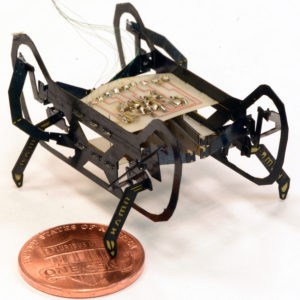
Source: Hardvard
HAMR is a versatile, 1.8-inch-long robotic platform that resembles a cockroach. The HAMR itself weighs in under an ounce and can run, jump and carry small items about twice its own weight. It is fast and can move with the speed of almost 19 inches per second.
HAMR has given the researchers a useful base idea from which they can build other ideas. For example, the HAMR-F, an enhanced version of HAMR doesn’t have any restraining wires. It can move around independently, it’s only slightly heavier (2.8g) and slower than the HAMR. It is powered by a micro 8mA lithium polymer battery. Scientists at Harvard’s School of Engineering and Applied Sciences also added footpads recently that allows the microbot to swim on water surface, sink and walk under water.
Robotic bees: RoboBees
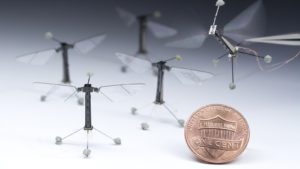
Source: Harvard
Like the HAMR, the RoboBee by Harvard has improved over time, it can also fly and swim. Its first successful flight was in 2013 and in 2015 it was able to swim. More recently in 2016, it gained the ability to “perch” on surfaces using static electricity. This allows the RoboBee to save power for loner flights. The 80-milligram robot can take a swim, leap up from the water, and then land. The RoboBee can flap its wings at 220 to 300 hertz in air and 9 to 13 hertz in water.
μRobotex: microbots from France
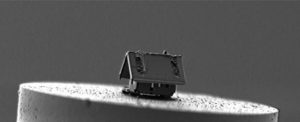
Source: Sciencealert
Scientists from the Femto-ST Institute in France have built the μRobotex platform. It is a new, extremely small microrobot system. This system has been able to build the smallest house in the world inside a vacuum chamber. The robot used an ion beam to cut a silica membrane to tiny pieces for assembly. The micro house is 0.015 mm high and 0.020 mm broad. In comparison, a grain of sand is anywhere from 0.05 mm to 2 mm in diameter. The completed house was kept on the tip of an optical fiber piece as shown in the image above.
Salto: a one-legged jumper
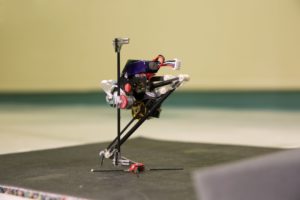
Source: Wired
Saltatorial locomotion on terrain obstacles (Salto), developed at University of California, is a one-legged jumping robot that is 10.2 inches tall when fully extended. It weighs about 100 grams, and can jump up to 1 meter in air. Salto’s skills show when it can do more than just a single jump. It can bounce off walls and can perform several jumps in a row while avoiding obstacles. Salto was inspired by the galago, a small mammal expert at jumping. The idea of Salto was about robots that can leap over rubble, to provide emergency services. The newer model is the Salto-1P.
Rolls Royce’s SWARM robots
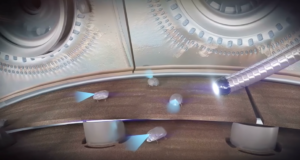
Source: Rolls Royce
Rolls-Royce teamed up with scholars from the University of Nottingham and Harvard University to develop independent tiny mobile robots called SWARM. They are about 0.4 inches in diameter. They are a part of Rolls-Royce’s IntelligentEngine program. The SWARM robots are put into position by a robotic snake and use tiny cameras to capture parts of an engine which are hard to access otherwise. This is very useful for mechanics to figure out what is wrong with a car engine with greater accessibility. The future plan for SWARM is to perform inspections of aircraft engines in order to not remove from the airplanes.
Short-Range Independent Microrobotic Platforms (SHRIMP)
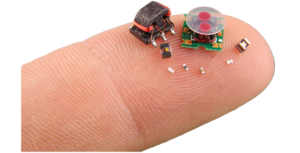
Source: DARPA
The Defense Advanced Research Project Agency (DARPA) wants to develop insect-scaled robots with, “untethered mobility, maneuverability, and dexterity.” In other words, they want microbots that can move around independently. DARPA is planning to sponsor these robots as part of the SHRIMP program for search and rescue, disaster relief, and hazardous environment inspection. It is also looking for robots that might work as prosthetics or eyes to see in places that are hard to reach.
These microbots are in early development stages but on entering production they will be very resourceful. From medical assistance to guided inspection in small areas, these microbots will prove to be useful in a variety of areas.
Read next
15 millions jobs in Britain at stake with AI robots set to replace humans at workforce
What Should We Watch Tonight? Ask a Robot, says Matt Jones from OVO Mobile [Interview]










![How to create sales analysis app in Qlik Sense using DAR method [Tutorial] Financial and Technical Data Analysis Graph Showing Search Findings](https://hub.packtpub.com/wp-content/uploads/2018/08/iStock-877278574-218x150.jpg)